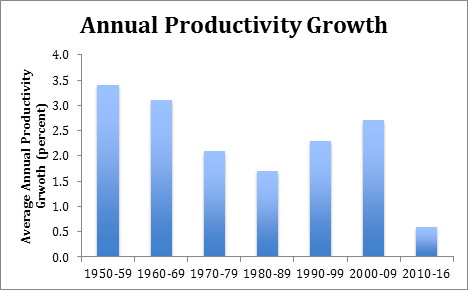The Daily Dish
August 10, 2016
Productivity is (Almost) Everything
The Association for Equipment Manufacturers released a bipartisan poll on Tuesday showing nearly half of all American voters believe American infrastructure has deteriorated in the past five years. According to the survey, 70 percent of those asked believe federal, state, and local governments should do more to upgrade the nation’s infrastructure. A report released in May by the American Society of Civil Engineers (ASCE) found the U.S. will be $1.44 trillion short of what it needs for proper infrastructure spending over the next ten years.
According to a new survey released on Tuesday by the Federal Reserve Bank of New York, American household debt is up $434 billion from this time last year and now stands at $12.29 trillion. The survey also shows that out of the $12.29 trillion in debt, approximately 4.8 percent of that debt is currently in some form of delinquency. The average credit limit for Americans has increased for the 14th straight quarter according to the survey.
Eakinomics: Productivity is (Almost) Everything
The Bureau of Labor Statistics (BLS) announced that productivity fell for the 3rd straight quarter. This is simply bad news and continues a bad decade for U.S. productivity growth (see chart).
Why does productivity growth matter? Let’s look at an example. Suppose I’m making 100 widgets (economics examples are always widgets; I don’t know why) and can sell them at $10 a piece. That gives me revenue of $1,000. To make things concrete, let’s assume I employ 10 people and pay them $80 each. Notice that the total wage bill is $800 and average productivity is 10 widgets per worker.
The first impact of productivity is on inflation pressures and Fed decision-making. In my example, suppose productivity falls to 9 widgets per worker – for a total of only 90 widgets. The only way I can keep my revenue at $1,000 is to raise the price from $10.00 to $11.11.
The second impact is on labor costs and profitability. Notice that as a result of the productivity decline, the labor cost per widget has risen from $8.00 to $8.89. Since labor is already more costly, it is tougher to imagine providing raises. This is especially true because – in the absence of a price increase – profits overall have declined from $200 to $100 and profit per widget is down from $2.00 to $1.11. I’ll be hearing from my shareholders.
These impacts are all different sides of the same coin – poor productivity puts downward pressure on wages and profits (which are distributed as interest, dividend and capital gains) and upward pressure on inflation.
But suppose instead productivity went up by 10 percent instead and each worker produced 11 widgets. At $10 a widget, there is $1,100 in revenue. I could easily pay each worker $88, which would keep the labor cost per widget at $8.00 (instead of falling to $7.27) and raise the total wages paid to $880. Notice, however, that even if I do that, profits rise and profits per widget remain constant at $2. In short, no upward pressure on prices, higher wages, and solid profitability. (One could imagine other combinations of prices, wages, and profits as well.)
Over long periods of time, Paul Krugman said it best in his book The Age of Diminished Expectations: “Productivity isn’t everything, but in the long run it is almost everything. A country’s ability to improve its standard of living over time depends almost entirely on its ability to raise its output per worker.” In 1929, the population of the United States was 122 million and it produced $1.1 trillion (in 2009 dollars) of Gross Domestic Product (GDP). By 2015, the population had risen by 164 percent to 322 million. But GDP (again, in 2009 dollars) had risen by 487 percent to $16.4 trillion. That’s the power of sustained productivity growth: GDP per person increasing from $8,600 to $51,000.
Poor productivity growth is the most pressing economic issue. Unfortunately, there is no single magic lever for policymakers to pull in order raise the growth rate. It responds to an environment of vigorous competition, entry of new and entrepreneurial firms, robust capital investment, research and innovation, access to risk capital, and low taxes on the reward to saving, investment and innovation. In short, it responds to a serious pro-growth policy platform.
Fact of the Day
The Environmental Protection Agency (EPA) imposes 188 million paperwork burden hours, a 23 percent increase since 2009.












